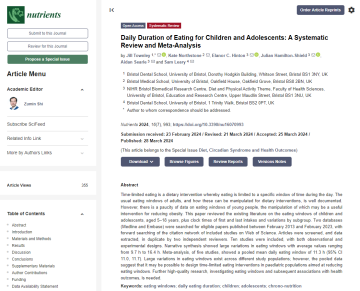Does time-restricted eating in children improve metabolic health?
Theme Diet and physical activity
Workstream Population diet and physical activity
Status: This project is ongoing
This project will explore whether time-restricted eating can improve metabolic health in children. Time-restricted eating involves eating all your meals during a specific time window without focusing on the number of calories you eat during that window. Metabolic health is a term we use to describe how well a person generates and processes energy in their body.
Project aims
- Establish average eating windows of children and adolescents
- Investigate associations between eating windows and metabolic health in children and adolescents
- Establish the feasibility of a time-limited eating intervention in UK children living with overweight or obesity
What we hope to achieve
We hope to use the findings from this project to apply for funding for a pilot study of a time-limited eating intervention to improve metabolic health in childhood. We hope that this pilot study may lead to a full-scale trial.
What we’ve done so far
We’ve carried out a systematic review of studies looking at time-limited eating in children. A systematic review analyses the evidence available on a specific topic. In this case we wanted to explore how long children and adolescents spent eating each day. This is called an ‘eating window’ and it is defined as the time between someone’s first and final meals of the day.
We found 10 studies that were eligible for our review. They looked at eating windows in 4,589 young people aged 6-20 years old and reported a wide range of eating window durations – from as short as 9.7 hours up to 16.4 hours per day.
On average, we calculated that children and adolescents were eating within a window of about 11.3 hours each day. Some of the studies we analysed suggested that eating windows tend to get longer as children get older, possibly due to staying awake later.
There was a lot of variation between studies, which could relate to different eating habits across cultures as well as how eating windows were measured. While an 11-hour average eating window seems long, our findings indicate time-restricted eating interventions aimed at reducing eating windows may be possible in young people.
However, more high-quality research is still needed in this area before any time-restricted eating programs could be recommended for children and adolescents. Future studies should focus on the potential links between eating windows and health in younger age groups.
This PhD project is being undertaken by Jill Townley, as lead researcher, with Dr Sam Leary, Dr Kate Northstone, Dr Ella Hinton and Professor Julian Hamilton-Shield providing supervision.
